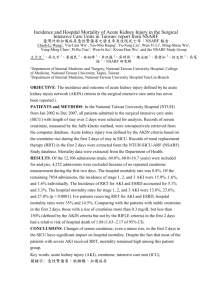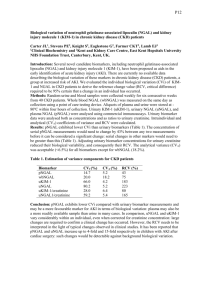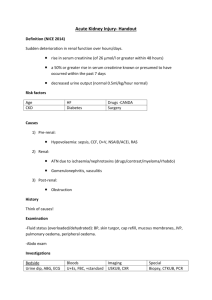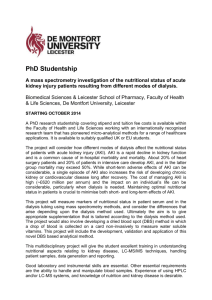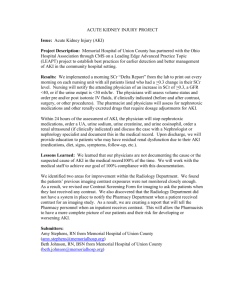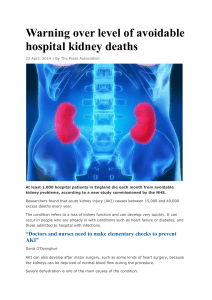Urinary Biomarkers of AKI and Mortality 3 Years after Cardiac Surgery
advertisement
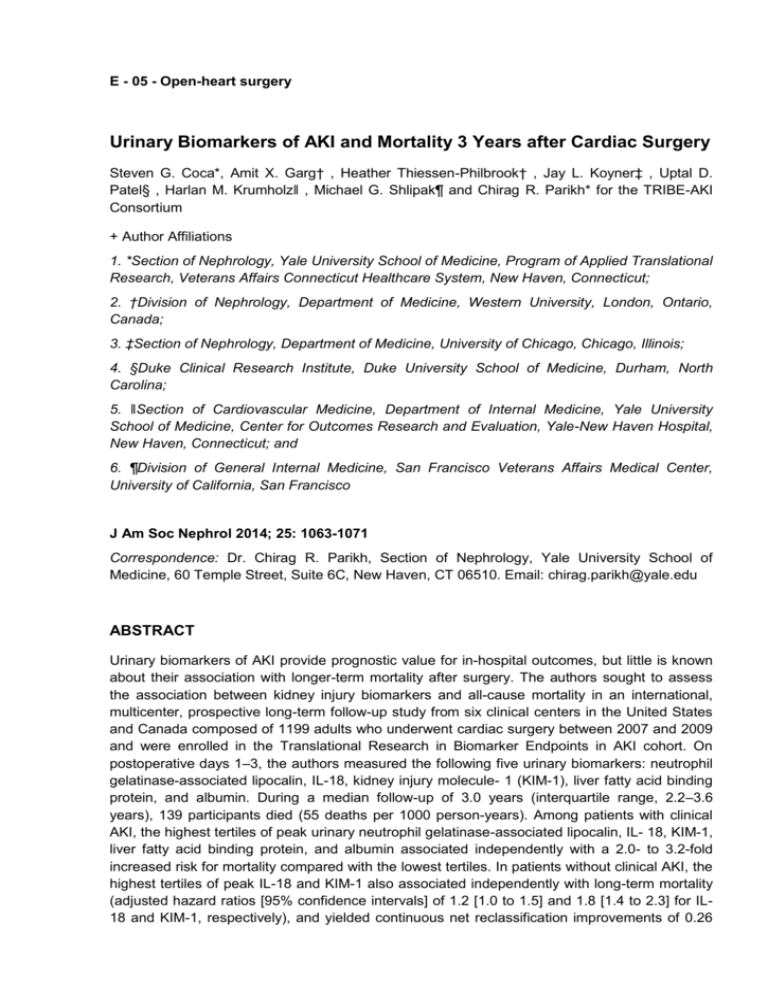
E - 05 - Open-heart surgery Urinary Biomarkers of AKI and Mortality 3 Years after Cardiac Surgery Steven G. Coca*, Amit X. Garg† , Heather Thiessen-Philbrook† , Jay L. Koyner‡ , Uptal D. Patel§ , Harlan M. Krumholz‖ , Michael G. Shlipak¶ and Chirag R. Parikh* for the TRIBE-AKI Consortium + Author Affiliations 1. *Section of Nephrology, Yale University School of Medicine, Program of Applied Translational Research, Veterans Affairs Connecticut Healthcare System, New Haven, Connecticut; 2. †Division of Nephrology, Department of Medicine, Western University, London, Ontario, Canada; 3. ‡Section of Nephrology, Department of Medicine, University of Chicago, Chicago, Illinois; 4. §Duke Clinical Research Institute, Duke University School of Medicine, Durham, North Carolina; 5. ‖Section of Cardiovascular Medicine, Department of Internal Medicine, Yale University School of Medicine, Center for Outcomes Research and Evaluation, Yale-New Haven Hospital, New Haven, Connecticut; and 6. ¶Division of General Internal Medicine, San Francisco Veterans Affairs Medical Center, University of California, San Francisco J Am Soc Nephrol 2014; 25: 1063-1071 Correspondence: Dr. Chirag R. Parikh, Section of Nephrology, Yale University School of Medicine, 60 Temple Street, Suite 6C, New Haven, CT 06510. Email: chirag.parikh@yale.edu ABSTRACT Urinary biomarkers of AKI provide prognostic value for in-hospital outcomes, but little is known about their association with longer-term mortality after surgery. The authors sought to assess the association between kidney injury biomarkers and all-cause mortality in an international, multicenter, prospective long-term follow-up study from six clinical centers in the United States and Canada composed of 1199 adults who underwent cardiac surgery between 2007 and 2009 and were enrolled in the Translational Research in Biomarker Endpoints in AKI cohort. On postoperative days 1–3, the authors measured the following five urinary biomarkers: neutrophil gelatinase-associated lipocalin, IL-18, kidney injury molecule- 1 (KIM-1), liver fatty acid binding protein, and albumin. During a median follow-up of 3.0 years (interquartile range, 2.2–3.6 years), 139 participants died (55 deaths per 1000 person-years). Among patients with clinical AKI, the highest tertiles of peak urinary neutrophil gelatinase-associated lipocalin, IL- 18, KIM-1, liver fatty acid binding protein, and albumin associated independently with a 2.0- to 3.2-fold increased risk for mortality compared with the lowest tertiles. In patients without clinical AKI, the highest tertiles of peak IL-18 and KIM-1 also associated independently with long-term mortality (adjusted hazard ratios [95% confidence intervals] of 1.2 [1.0 to 1.5] and 1.8 [1.4 to 2.3] for IL18 and KIM-1, respectively), and yielded continuous net reclassification improvements of 0.26 and 0.37, respectively, for the prediction of 3-year mortality. In conclusion, urinary biomarkers of kidney injury, particularly IL-18 and KIM-1, in the immediate postoperative period provide additional prognostic information for 3-year mortality risk in patients with and without clinical AKI. COMMENTS In many studies, the development of AKI, defined by acute changes in serum creatinine, associates with a higher risk of long-term mortality. Acute changes in serum creatinine, however, may not fully reflect the severity of kidney injury due to the influence of age, sex, muscle mass, changes in hydration, nutritional status, and medications on creatinine kinetics. Moreover, serum creatinine may abruptly rise in hospitalized settings due to functional processes such as altered hemodynamics, without any true nephron damage. Several urinary biomarkers of structural kidney injury have been investigated in human cohorts in an effort to identify AKI earlier, improve the diagnosis of AKI, and to aid in risk stratification. It is largely unknown, however, whether kidney injury biomarkers associate with long-term outcomes, including mortality, and whether these biomarkers add useful prognostic information beyond the standard measure to detect AKI (e.g., peak change in serum creatinine). Some data suggest that “subclinical AKI,” as evidenced by elevations in urinary kidney injury biomarkers in the absence of a rise in serum creatinine, associates with worse in-hospital clinical outcomes. Few studies have examined whether kidney injury biomarkers associate with long-term mortality after hospital discharge These results indicate that urinary biomarkers not only provide added prognostic information in those with clinical AKI, but potentially support a revised paradigm in which even subclinical AKI may confer increased risk for adverse outcomes. The absolute mortality rate for patients in the upper tertiles of urinary biomarkers of kidney injury that had no apparent clinical AKI approximated that of those in the first tertile of urinary injury biomarker concentrations with clinical AKI. Thus, if validated in future studies, our results suggest that definitions of kidney injury should be based on changes in urinary biomarkers in addition to changes in serum creatinine.
